woensdag 25 april 2012
Category Celebrities - page 1
Adriana Lima,Alicia Silverstone,Alison Lohman,Alizee,Alyssa Milano,Amanda Seyfried,Ana Ivanovic,Angelina Jolie,Anna Kournikova,Anna Paquin,Anne Hathaway,Ashlee Simpson ,Ashley Tisdale ,Avril Lavigne ,Beyonce Knowles ,Britney Spears
woensdag 11 april 2012
marketing stappenplan,marketingstrategie,business plan,marketing plan,example,social media marketing plan,marketing plan template,online marketing plan,marketingstrategie,marketingplan,online marketing,marketing definitie,guerilla marketing,marketing vacatures,marketing opleiding,marketing studeren
business plan,
business contact,
business for sale,
business intelligence,
business case,
reed business,
business lease,
business post,
business plan maken,
business plan template,
ondernemingsplan,
business plan checklist,
business plan wizard,rabobank business plan,format business plan, ing business plan,Zoekopdrachten, gerelateerd, aan business plan template,business plan ,template word,business plan template excel,businessplan voorbeeld,businessplan schrijven,ondernemingsplan template,businessplan opstellen,ondernemingsplan,ondernemingsplan voorbeeld, plan synoniem,marketing plan,business plan,strategisch plan,simple plan,lease plan,plan heist op den berg,plan vzw,marketing plan voorbeeld,
marketing stappenplan,marketingstrategie,business plan,marketing plan,example,social media marketing plan,marketing plan template,online marketing plan,marketingstrategie,marketingplan,online marketing,marketing definitie,guerilla marketing,marketing vacatures,marketing opleiding,marketing studeren
business contact,
business for sale,
business intelligence,
business case,
reed business,
business lease,
business post,
business plan maken,
business plan template,
ondernemingsplan,
business plan checklist,
business plan wizard,rabobank business plan,format business plan, ing business plan,Zoekopdrachten, gerelateerd, aan business plan template,business plan ,template word,business plan template excel,businessplan voorbeeld,businessplan schrijven,ondernemingsplan template,businessplan opstellen,ondernemingsplan,ondernemingsplan voorbeeld, plan synoniem,marketing plan,business plan,strategisch plan,simple plan,lease plan,plan heist op den berg,plan vzw,marketing plan voorbeeld,
marketing stappenplan,marketingstrategie,business plan,marketing plan,example,social media marketing plan,marketing plan template,online marketing plan,marketingstrategie,marketingplan,online marketing,marketing definitie,guerilla marketing,marketing vacatures,marketing opleiding,marketing studeren
marketing plan
A marketing plan may be part of an overall business plan. Solid marketing strategy is the foundation of a well-written marketing plan. While a marketing plan contains a list of actions, a marketing plan without a sound strategic foundation is of little use.
To be most effective, the plan has to be formalized, usually in written form, as a formal "marketing plan." The essence of the process is that it moves from the general to the specific, from the vision to the mission to the goals to the corporate objectives of the organization, then down to the individual action plans for each part of the marketing program. It is also an interactive process, so that the draft output of each stage is checked to see what impact it has on the earlier stages, and is amended.
This "corporate mission" can be thought of as a definition of what the organization is, of what it does: "Our business is ...". This definition should not be too narrow, or it will constrict the development of the organization; a too rigorous concentration on the view that "We are in the business of making meat-scales," as IBM was during the early 1900s, might have limited its subsequent development into other areas. On the other hand, it should not be too wide or it will become meaningless; "We want to make a profit" is not too helpful in developing specific plans.
Abell suggested that the definition should cover three dimensions: "customer groups" to be served, "customer needs" to be served, and "technologies" to be used.[1] Thus, the definition of IBM's "corporate mission" in the 1940s might well have been: "We are in the business of handling accounting information [customer need] for the larger US organizations [customer group] by means of punched cards [technology]."
Perhaps the most important factor in successful marketing is the "corporate vision." Surprisingly, it is largely neglected by marketing textbooks, although not by the popular exponents of corporate strategy — indeed, it was perhaps the main theme of the book by Peters and Waterman, in the form of their "Superordinate Goals." "In Search of Excellence" said: "Nothing drives progress like the imagination. The idea precedes the deed." [2] If the organization in general, and its chief executive in particular, has a strong vision of where its future lies, then there is a good chance that the organization will achieve a strong position in its markets (and attain that future). This will be not least because its strategies will be consistent and will be supported by its staff at all levels. In this context, all of IBM's marketing activities were underpinned by its philosophy of "customer service," a vision originally promoted by the charismatic Watson dynasty. The emphasis at this stage is on obtaining a complete and accurate picture.
A "traditional" — albeit product-based — format for a "brand reference book" (or, indeed, a "marketing facts book") was suggested by Godley more than three decades ago:
It is apparent that a marketing audit can be a complex process, but the aim is simple: "it is only to identify those existing (external and internal) factors which will have a significant impact on the future plans of the company." It is clear that the basic material to be input to the marketing audit should be comprehensive.
Accordingly, the best approach is to accumulate this material continuously, as and when it becomes available; since this avoids the otherwise heavy workload involved in collecting it as part of the regular, typically annual, planning process itself — when time is usually at a premium.
Even so, the first task of this annual process should be to check that the material held in the current facts book or facts files actually is comprehensive and accurate, and can form a sound basis for the marketing audit itself.
The structure of the facts book will be designed to match the specific needs of the organization, but one simple format — suggested by Malcolm McDonald — may be applicable in many cases. This splits the material into three groups:
The "marketing objectives" state just where the company intends to be at some specific time in the future.
James Quinn succinctly defined objectives in general as: Goals (or objectives) state what is to be achieved and when results are to be accomplished, but they do not state "how" the results are to be achieved.[3] They typically relate to what products (or services) will be where in what markets (and must be realistically based on customer behavior in those markets). They are essentially about the match between those "products" and "markets." Objectives for pricing, distribution, advertising and so on are at a lower level, and should not be confused with marketing objectives. They are part of the marketing strategy needed to achieve marketing objectives. To be most effective, objectives should be capable of measurement and therefore "quantifiable." This measurement may be in terms of sales volume, money value, market share, percentage penetration of distribution outlets and so on. An example of such a measurable marketing objective might be "to enter the market with product Y and capture 10 percent of the market by value within one year." As it is quantified it can, within limits, be unequivocally monitored, and corrective action taken as necessary.
The marketing objectives must usually be based, above all, on the organization's financial objectives; converting these financial measurements into the related marketing measurements.He went on to explain his view of the role of "policies," with which strategy is most often confused: "Policies are rules or guidelines that express the 'limits' within which action should occur."Simplifying somewhat, marketing strategies can be seen as the means, or "game plan," by which marketing objectives will be achieved and, in the framework that we have chosen to use, are generally concerned with the 8 P's. Examples are:
In principle, these strategies describe how the objectives will be achieved. The 7 Ps are a useful framework for deciding how the company's resources will be manipulated (strategically) to achieve the objectives. However, they are not the only framework, and may divert attention from the real issues. The focus of the strategies must be the objectives to be achieved — not the process of planning itself. Only if it fits the needs of these objectives should you choose, as we have done, to use the framework of the 7 Ps.
The strategy statement can take the form of a purely verbal description of the strategic options which have been chosen. Alternatively, and perhaps more positively, it might include a structured list of the major options chosen.
One aspect of strategy which is often overlooked is that of "timing." Exactly when it is the best time for each element of the strategy to be implemented is often critical. Taking the right action at the wrong time can sometimes be almost as bad as taking the wrong action at the right time. Timing is, therefore, an essential part of any plan; and should normally appear as a schedule of planned activities.Having completed this crucial stage of the planning process, you will need to re-check the feasibility of your objectives and strategies in terms of the market share, sales, costs, profits and so on which these demand in practice. As in the rest of the marketing discipline, you will need to employ judgment, experience, market research or anything else which helps you to look at your conclusions from all possible angles.
Again, the most important element is, indeed, that of the detailed plans, which spell out exactly what programs and individual activities will take place over the period of the plan (usually over the next year). Without these specified — and preferably quantified — activities the plan cannot be monitored, even in terms of success in meeting its objectives.It is these programs and activities which will then constitute the "marketing" of the organization over the period. As a result, these detailed marketing programs are the most important, practical outcome of the whole planning process. These plans must therefore be:
Changes in the environment mean that the forecasts often have to be changed. Along with these, the related plans may well also need to be changed. Continuous monitoring of performance, against predetermined targets, represents a most important aspect of this. However, perhaps even more important is the enforced discipline of a regular formal review. Again, as with forecasts, in many cases the best (most realistic) planning cycle will revolve around a quarterly review. Best of all, at least in terms of the quantifiable aspects of the plans, if not the wealth of backing detail, is probably a quarterly rolling review — planning one full year ahead each new quarter. Of course, this does absorb more planning resource; but it also ensures that the plans embody the latest information, and — with attention focused on them so regularly — forces both the plans and their implementation to be realistic.
Plans only have validity if they are actually used to control the progress of a company: their success lies in their implementation, not in the writing'.
`Micro-analysis', which is simply the normal management process of investigating detailed problems, then investigates the individual elements (individual products, sales territories, customers and so on) which are failing to meet targets.
There can be considerable benefit in comparing these figures with those achieved by other organizations (especially those in the same industry); using, for instance, the figures which can be obtained (in the UK) from `The Centre for Interfirm Comparison'. The most sophisticated use of this approach, however, is typically by those making use of PIMS (Profit Impact of Management Strategies), initiated by the General Electric Company and then developed by Harvard Business School, but now run by the Strategic Planning Institute.
The above performance analyses concentrate on the quantitative measures which are directly related to short-term performance. But there are a number of indirect measures, essentially tracking customer attitudes, which can also indicate the organization's performance in terms of its longer-term marketing strengths and may accordingly be even more important indicators. Some useful measures are:
The purpose of a marketing budget is, thus, to pull together all the revenues and costs involved in marketing into one comprehensive document. It is a managerial tool that balances what is needed to be spent against what can be afforded, and helps make choices about priorities. It is then used in monitoring performance in practice.
The marketing budget is usually the most powerful tool by which you think through the relationship between desired results and available means. Its starting point should be the marketing strategies and plans, which have already been formulated in the marketing plan itself; although, in practice, the two will run in parallel and will interact. At the very least, the rigorous, highly quantified, budgets may cause a rethink of some of the more optimistic elements of the plans.
Contents[hide] |
The marketing planning process
Marketing process can be realized by the marketing mix in step 4. The last step in the process is the marketing controlling. In most organizations, "strategic planning" is an annual process, typically covering just the year ahead. Occasionally, a few organizations may look at a practical plan which stretches three or more years ahead.To be most effective, the plan has to be formalized, usually in written form, as a formal "marketing plan." The essence of the process is that it moves from the general to the specific, from the vision to the mission to the goals to the corporate objectives of the organization, then down to the individual action plans for each part of the marketing program. It is also an interactive process, so that the draft output of each stage is checked to see what impact it has on the earlier stages, and is amended.
Marketing planning aims and objectives
Behind the corporate objectives, which in themselves offer the main context for the marketing plan, will lie the "corporate mission," which in turn provides the context for these corporate objectives. In a sales-oriented organization, the marketing planning function designs incentive pay plans to not only motivate and reward frontline staff fairly but also to align marketing activities with corporate mission.This "corporate mission" can be thought of as a definition of what the organization is, of what it does: "Our business is ...". This definition should not be too narrow, or it will constrict the development of the organization; a too rigorous concentration on the view that "We are in the business of making meat-scales," as IBM was during the early 1900s, might have limited its subsequent development into other areas. On the other hand, it should not be too wide or it will become meaningless; "We want to make a profit" is not too helpful in developing specific plans.
Abell suggested that the definition should cover three dimensions: "customer groups" to be served, "customer needs" to be served, and "technologies" to be used.[1] Thus, the definition of IBM's "corporate mission" in the 1940s might well have been: "We are in the business of handling accounting information [customer need] for the larger US organizations [customer group] by means of punched cards [technology]."
Perhaps the most important factor in successful marketing is the "corporate vision." Surprisingly, it is largely neglected by marketing textbooks, although not by the popular exponents of corporate strategy — indeed, it was perhaps the main theme of the book by Peters and Waterman, in the form of their "Superordinate Goals." "In Search of Excellence" said: "Nothing drives progress like the imagination. The idea precedes the deed." [2] If the organization in general, and its chief executive in particular, has a strong vision of where its future lies, then there is a good chance that the organization will achieve a strong position in its markets (and attain that future). This will be not least because its strategies will be consistent and will be supported by its staff at all levels. In this context, all of IBM's marketing activities were underpinned by its philosophy of "customer service," a vision originally promoted by the charismatic Watson dynasty. The emphasis at this stage is on obtaining a complete and accurate picture.
A "traditional" — albeit product-based — format for a "brand reference book" (or, indeed, a "marketing facts book") was suggested by Godley more than three decades ago:
- Financial data—Facts for this section will come from management accounting, costing and finance sections.
- Product data—From production, research and development.
- Sales and distribution data — Sales, packaging, distribution sections.
- Advertising, sales promotion, merchandising data — Information from these departments.
- Market data and miscellany — From market research, who would in most cases act as a source for this information. His sources of data, however, assume the resources of a very large organization. In most organizations they would be obtained from a much smaller set of people (and not a few of them would be generated by the marketing manager alone).
It is apparent that a marketing audit can be a complex process, but the aim is simple: "it is only to identify those existing (external and internal) factors which will have a significant impact on the future plans of the company." It is clear that the basic material to be input to the marketing audit should be comprehensive.
Accordingly, the best approach is to accumulate this material continuously, as and when it becomes available; since this avoids the otherwise heavy workload involved in collecting it as part of the regular, typically annual, planning process itself — when time is usually at a premium.
Even so, the first task of this annual process should be to check that the material held in the current facts book or facts files actually is comprehensive and accurate, and can form a sound basis for the marketing audit itself.
The structure of the facts book will be designed to match the specific needs of the organization, but one simple format — suggested by Malcolm McDonald — may be applicable in many cases. This splits the material into three groups:
- Review of the marketing environment. A study of the organization's markets, customers, competitors and the overall economic, political, cultural and technical environment; covering developing trends, as well as the current situation.
- Review of the detailed marketing activity. A study of the company's marketing mix; in terms of the 7 Ps - (see below)
- Review of the marketing system. A study of the marketing organization, marketing research systems and the current marketing objectives and strategies. The last of these is too frequently ignored. The marketing system itself needs to be regularly questioned, because the validity of the whole marketing plan is reliant upon the accuracy of the input from this system, and `garbage in, garbage out' applies with a vengeance.
- Portfolio planning. In addition, the coordinated planning of the individual products and services can contribute towards the balanced portfolio.
- 80:20 rule. To achieve the maximum impact, the marketing plan must be clear, concise and simple. It needs to concentrate on the 20 percent of products or services, and on the 20 percent of customers, that will account for 80 percent of the volume and 80 percent of the profit.
- 7 Ps: Product, Place, Price and Promotion, Physical Environment, People, Process. The 7 Ps can sometimes divert attention from the customer, but the framework they offer can be very useful in building the action plans.
The "marketing objectives" state just where the company intends to be at some specific time in the future.
James Quinn succinctly defined objectives in general as: Goals (or objectives) state what is to be achieved and when results are to be accomplished, but they do not state "how" the results are to be achieved.[3] They typically relate to what products (or services) will be where in what markets (and must be realistically based on customer behavior in those markets). They are essentially about the match between those "products" and "markets." Objectives for pricing, distribution, advertising and so on are at a lower level, and should not be confused with marketing objectives. They are part of the marketing strategy needed to achieve marketing objectives. To be most effective, objectives should be capable of measurement and therefore "quantifiable." This measurement may be in terms of sales volume, money value, market share, percentage penetration of distribution outlets and so on. An example of such a measurable marketing objective might be "to enter the market with product Y and capture 10 percent of the market by value within one year." As it is quantified it can, within limits, be unequivocally monitored, and corrective action taken as necessary.
The marketing objectives must usually be based, above all, on the organization's financial objectives; converting these financial measurements into the related marketing measurements.He went on to explain his view of the role of "policies," with which strategy is most often confused: "Policies are rules or guidelines that express the 'limits' within which action should occur."Simplifying somewhat, marketing strategies can be seen as the means, or "game plan," by which marketing objectives will be achieved and, in the framework that we have chosen to use, are generally concerned with the 8 P's. Examples are:
- Price — The amount of money needed to buy products
- Product — The actual product
- Promotion (advertising)- Getting the product known
- Placement — Where the product is sold
- People — Represent the business
- Physical environment — The ambiance, mood, or tone of the environment
- Process — The Value-added services that differentiate the product from the competition (e.g. after-sales service, warranties)
- Packaging — How the product will be protected
In principle, these strategies describe how the objectives will be achieved. The 7 Ps are a useful framework for deciding how the company's resources will be manipulated (strategically) to achieve the objectives. However, they are not the only framework, and may divert attention from the real issues. The focus of the strategies must be the objectives to be achieved — not the process of planning itself. Only if it fits the needs of these objectives should you choose, as we have done, to use the framework of the 7 Ps.
The strategy statement can take the form of a purely verbal description of the strategic options which have been chosen. Alternatively, and perhaps more positively, it might include a structured list of the major options chosen.
One aspect of strategy which is often overlooked is that of "timing." Exactly when it is the best time for each element of the strategy to be implemented is often critical. Taking the right action at the wrong time can sometimes be almost as bad as taking the wrong action at the right time. Timing is, therefore, an essential part of any plan; and should normally appear as a schedule of planned activities.Having completed this crucial stage of the planning process, you will need to re-check the feasibility of your objectives and strategies in terms of the market share, sales, costs, profits and so on which these demand in practice. As in the rest of the marketing discipline, you will need to employ judgment, experience, market research or anything else which helps you to look at your conclusions from all possible angles.
Detailed plans and programs
At this stage,you will need to develop your overall marketing strategies into detailed plans and program. Although these detailed plans may cover each of the 7 Ps (marketing mix), the focus will vary, depending upon your organization's specific strategies. A product-oriented company will focus its plans for the 7 Ps around each of its products. A market or geographically oriented company will concentrate on each market or geographical area. Each will base its plans upon the detailed needs of its customers, and on the strategies chosen to satisfy these needs. Brochures and Websites are used effectively.Again, the most important element is, indeed, that of the detailed plans, which spell out exactly what programs and individual activities will take place over the period of the plan (usually over the next year). Without these specified — and preferably quantified — activities the plan cannot be monitored, even in terms of success in meeting its objectives.It is these programs and activities which will then constitute the "marketing" of the organization over the period. As a result, these detailed marketing programs are the most important, practical outcome of the whole planning process. These plans must therefore be:
- Clear - They should be an unambiguous statement of 'exactly' what is to be done.
- Quantified - The predicted outcome of each activity should be, as far as possible, quantified, so that its performance can be monitored.
- Focused - The temptation to proliferate activities beyond the numbers which can be realistically controlled should be avoided. The 80:20 Rule applies in this context too.
- Realistic - They should be achievable.
- Agreed - Those who are to implement them should be committed to them, and agree that they are achievable. The resulting plans should become a working document which will guide the campaigns taking place throughout the organization over the period of the plan. If the marketing plan is to work, every exception to it (throughout the year) must be questioned; and the lessons learnt, to be incorporated in the next year's .
Content of the marketing plan
A marketing plan for a small business typically includes Small Business Administration Description of competitors, including the level of demand for the product or service and the strengths and weaknesses of competitors- Description of the product or service, including special features
- Marketing budget, including the advertising and promotional plan
- Description of the business location, including advantages and disadvantages for marketing
- Pricing strategy
- Market Segmentation
Medium-sized and large organizations
The main contents of a marketing plan are:[4]- Executive Summary
- Situational Analysis
- Opportunities / Issue Analysis - SWOT Analysis
- Objectives
- Strategy
- Action Program (the operational marketing plan itself for the period under review)
- Financial Forecast
- Controls
- Title page
- Executive Summary
- Current Situation - Macroenvironment
- economy
- legal
- government
- technology
- ecological
- sociocultural
- supply chain
- Current Situation - Market Analysis
- market definition
- market size
- market segmentation
- industry structure and strategic groupings
- Porter 5 forces analysis
- competition and market share
- competitors' strengths and weaknesses
- market trends
- Current Situation — Consumer Analysis [5]
- nature of the buying decision
- participants
- demographics
- psychographics
- buyer motivation and expectations
- loyalty segments
- Current Situation — Internal
- company resources
- financial
- people
- time
- skills
- objectives
- mission statement and vision statement
- corporate objectives
- financial objective
- marketing objectives
- long term objectives
- description of the basic business philosophy
- corporate culture
- company resources
- Summary of Situation Analysis
- external threats
- external opportunities
- internal strengths
- internal weaknesses
- Critical success factors in the industry
- our sustainable competitive advantage
- Marketing research
- information requirements
- research methodology
- research results
- Marketing Strategy - Product
- product mix
- product strengths and weaknesses
- product life cycle management and new product development
- Brand name, brand image, and brand equity
- the augmented product
- product portfolio analysis
- Marketing Strategy [6] - segmented marketing actions and market share objectives
- by product,
- by customer segment,
- by geographical market,
- by distribution channel.
- Marketing Strategy - Price
- pricing objectives
- pricing method (e.g.: cost plus, demand based, or competitor indexing)
- pricing strategy (e.g.: skimming, or penetration)
- discounts and allowances
- price elasticity and customer sensitivity
- price zoning
- break even analysis at various prices
- Marketing Strategy - promotion
- promotional goals
- promotional mix
- advertising reach, frequency, flights, theme, and media
- sales force requirements, techniques, and management
- sales promotion
- publicity and public relations
- electronic promotion (e.g.: Web, or telephone)
- word of mouth marketing (buzz)
- viral marketing
- Marketing Strategy - Distribution
- geographical coverage
- distribution channels
- physical distribution and logistics
- electronic distribution
- Implementation
- personnel requirements
- assign responsibilities
- give incentives
- training on selling methods
- financial requirements
- management information systems requirements
- month-by-month agenda
- monitoring results and benchmarks
- adjustment mechanism
- contingencies (What if's)
- personnel requirements
- Financial Summary
- assumptions
- pro-forma monthly income statement
- contribution margin analysis
- breakeven analysis
- Monte Carlo method
- ISI: Internet Strategic Intelligence
- Scenarios
- Prediction of Future Scenarios
- Plan of Action for each Scenario
- Appendix
- pictures and specifications of the new product
- results from research already completed
Measurement of progress
The final stage of any marketing planning process is to establish targets (or standards) so that progress can be monitored. Accordingly, it is important to put both quantities and timescales into the marketing objectives (for example, to capture 20 percent by value of the market within two years) and into the corresponding strategies.Changes in the environment mean that the forecasts often have to be changed. Along with these, the related plans may well also need to be changed. Continuous monitoring of performance, against predetermined targets, represents a most important aspect of this. However, perhaps even more important is the enforced discipline of a regular formal review. Again, as with forecasts, in many cases the best (most realistic) planning cycle will revolve around a quarterly review. Best of all, at least in terms of the quantifiable aspects of the plans, if not the wealth of backing detail, is probably a quarterly rolling review — planning one full year ahead each new quarter. Of course, this does absorb more planning resource; but it also ensures that the plans embody the latest information, and — with attention focused on them so regularly — forces both the plans and their implementation to be realistic.
Plans only have validity if they are actually used to control the progress of a company: their success lies in their implementation, not in the writing'.
Performance analysis
Sales analysis
Most organizations track their sales results; or, in non-profit organizations for example, the number of clients. The more sophisticated track them in terms of 'sales variance' - the deviation from the target figures — which allows a more immediate picture of deviations to become evident.`Micro-analysis', which is simply the normal management process of investigating detailed problems, then investigates the individual elements (individual products, sales territories, customers and so on) which are failing to meet targets.
Market share analysis
Few organizations track market share though it is often an important metric. Though absolute sales might grow in an expanding market, a firm's share of the market can decrease which bodes ill for future sales when the market starts to drop. Where such market share is tracked, there may be a number of aspects which will be followed:- overall market share
- segment share — that in the specific, targeted segment
- relative share -in relation to the market leaders
- annual fluctuation rate of market share
- also the specific market sharing of customers.
Expense analysis
The key ratio to watch in this area is usually the `marketing expense to sales ratio'; although this may be broken down into other elements (advertising to sales, sales administration to sales, and so on).Financial analysis
The "bottom line" of marketing activities should at least in theory, be the net profit (for all except non-profit organizations, where the comparable emphasis may be on remaining within budgeted costs). There are a number of separate performance figures and key ratios which need to be tracked:There can be considerable benefit in comparing these figures with those achieved by other organizations (especially those in the same industry); using, for instance, the figures which can be obtained (in the UK) from `The Centre for Interfirm Comparison'. The most sophisticated use of this approach, however, is typically by those making use of PIMS (Profit Impact of Management Strategies), initiated by the General Electric Company and then developed by Harvard Business School, but now run by the Strategic Planning Institute.
The above performance analyses concentrate on the quantitative measures which are directly related to short-term performance. But there are a number of indirect measures, essentially tracking customer attitudes, which can also indicate the organization's performance in terms of its longer-term marketing strengths and may accordingly be even more important indicators. Some useful measures are:
- market research — including customer panels (which are used to track changes over time)
- lost business — the orders which were lost because, for example, the stock was not available or the product did not meet the customer's exact requirements
- customer complaints — how many customers complain about the products or services, or the organization itself, and about what
Use of marketing plans
A formal, written marketing plan is essential; in that it provides an unambiguous reference point for activities throughout the planning period. However, perhaps the most important benefit of these plans is the planning process itself. This typically offers a unique opportunity, a forum, for information-rich and productively focused discussions between the various managers involved. The plan, together with the associated discussions, then provides an agreed context for their subsequent management activities, even for those not described in the plan itself. Additionally, marketing plans are included in business plans, offering data showing investors how the company will grow and most importantly, how they will get a return on investment.Budgets as managerial tools
The classic quantification of a marketing plan appears in the form of budgets. Because these are so rigorously quantified, they are particularly important. They should, thus, represent an unequivocal projection of actions and expected results. What is more, they should be capable of being monitored accurately; and, indeed, performance against budget is the main (regular) management review process.The purpose of a marketing budget is, thus, to pull together all the revenues and costs involved in marketing into one comprehensive document. It is a managerial tool that balances what is needed to be spent against what can be afforded, and helps make choices about priorities. It is then used in monitoring performance in practice.
The marketing budget is usually the most powerful tool by which you think through the relationship between desired results and available means. Its starting point should be the marketing strategies and plans, which have already been formulated in the marketing plan itself; although, in practice, the two will run in parallel and will interact. At the very least, the rigorous, highly quantified, budgets may cause a rethink of some of the more optimistic elements of the plans.
References
- ^ Abell, "Defining the Business: The Starting Point of Strategic Planning"
- ^ "The Marketing Imagination"
- ^ J. B. Quinn, "Strategies for Change: Logical Incrementalism" (Richard D. Irwin, 1980)
- ^ a b Baker, Michael The Strategic Marketing Plan Audit 2008. ISBN 1-902433-99-8
- ^ Quick MBA Marketing plan based on consumer and competitor analyses
- ^ Marketing plan basics Table of marketing targets, actions, means and results
- H. A. Simon, Rational decision making in business organisations, 'American Economic Review'
- J. Pfeffer and G. R. Salancik, 'The External Control of Organizations'
- K. Paolo Sumagaysay, "The oversaturated world"
business plan,business contact,business for sale,business intelligence,business case,reed business,business lease,business post,
A business plan is a formal statement of a set of business goals, the reasons why they are believed attainable, and the plan for reaching those goals. It may also contain background information about the organization or team attempting to reach those goals.
Business plans may also target changes in perception and branding by the customer, client, taxpayer, or larger community. When the existing business is to assume a major change or when planning a new venture, a 3 to 5 year business plan is required, since investors will look for their annual return in that timeframe.
Internally focused business plans target intermediate goals required to reach the external goals. They may cover the development of a new product, a new service, a new IT system, a restructuring of finance, the refurbishing of a factory or a restructuring of the organization. An internal business plan is often developed in conjunction with a balanced scorecard or a list of critical success factors. This allows success of the plan to be measured using non-financial measures. Business plans that identify and target internal goals, but provide only general guidance on how they will be met are called strategic plans.
Operational plans describe the goals of an internal organization, working group or department.[4] Project plans, sometimes known as project frameworks, describe the goals of a particular project. They may also address the project's place within the organization's larger strategic goals.
For example, a business plan for a non-profit might discuss the fit between the business plan and the organization’s mission. Banks are quite concerned about defaults, so a business plan for a bank loan will build a convincing case for the organization’s ability to repay the loan. Venture capitalists are primarily concerned about initial investment, feasibility, and exit valuation. A business plan for a project requiring equity financing will need to explain why current resources, upcoming growth opportunities, and sustainable competitive advantage will lead to a high exit valuation.
Preparing a business plan draws on a wide range of knowledge from many different business disciplines: finance, human resource management, intellectual property management, supply chain management, operations management, and marketing, among others.[6] It can be helpful to view the business plan as a collection of sub-plans, one for each of the main business disciplines.[7]
"... a good business plan can help to make a good business credible, understandable, and attractive to someone who is unfamiliar with the business. Writing a good business plan can’t guarantee success, but it can go a long way toward reducing the odds of failure."
This situation is complicated by the fact that many venture capitalists will refuse to sign an NDA before looking at a business plan, lest it put them in the untenable position of looking at two independently developed look-alike business plans, both claiming originality. In such situations one may need to develop two versions of the business plan: a stripped down plan that can be used to develop a relationship and a detail plan that is only shown when investors have sufficient interest and trust to sign an NDA.
An open business plan is a business plan with unlimited audience. The business plan is typically web published and made available to all.
In the free software and open source business model, trade secrets, copyright and patents can no longer be used as effective locking mechanisms to provide sustainable advantages to a particular business and therefore a secret business plan is less relevant in those models.
While the origin of the open business plan model is in the free software and Libre services arena, the concept is likely applicable to other domains.
The primary difference between profit and non-profit organizations is that "for-profit" organizations look to maximize wealth versus non-profit organizations, which look to provide a greater good to society. In non-profit organizations, creative tensions may develop in the effort to balance mission with "margin" (or revenue).
business plan,business contact,business for sale,business intelligence,business case,reed business,business lease,business post, business plan maken,business plan template,ondernemingsplan,business plan checklist,business plan wizard,rabobank business plan,format business plan, ing business plan,Zoekopdrachten, gerelateerd, aan business plan template,business plan ,template word,business plan template excel,businessplan voorbeeld,businessplan schrijven,ondernemingsplan template,businessplan opstellen,ondernemingsplan,ondernemingsplan voorbeeld,
Business plans may also target changes in perception and branding by the customer, client, taxpayer, or larger community. When the existing business is to assume a major change or when planning a new venture, a 3 to 5 year business plan is required, since investors will look for their annual return in that timeframe.
Audience
Business plans may be internally or externally focused. Externally focused plans target goals that are important to external stakeholders, particularly financial stakeholders. They typically have detailed information about the organization or team attempting to reach the goals. With for-profit entities, external stakeholders include investors and customers.[2] External stake-holders of non-profits include donors and the clients of the non-profit's services.[3] For government agencies, external stakeholders include tax-payers, higher-level government agencies, and international lending bodies such as the International Monetary Fund, the World Bank, various economic agencies of the United Nations, and development banks.Internally focused business plans target intermediate goals required to reach the external goals. They may cover the development of a new product, a new service, a new IT system, a restructuring of finance, the refurbishing of a factory or a restructuring of the organization. An internal business plan is often developed in conjunction with a balanced scorecard or a list of critical success factors. This allows success of the plan to be measured using non-financial measures. Business plans that identify and target internal goals, but provide only general guidance on how they will be met are called strategic plans.
Operational plans describe the goals of an internal organization, working group or department.[4] Project plans, sometimes known as project frameworks, describe the goals of a particular project. They may also address the project's place within the organization's larger strategic goals.
Content
For more details on this topic, see Content of a business plan.
Business plans are decision-making tools. There is no fixed content for a business plan. Rather the content and format of the business plan is determined by the goals and audience. A business plan represents all aspects of business planning process declaring vision and strategy alongside sub-plans to cover marketing, finance, operations, human resources as well as a legal plan, when required. A business plan is a summary of those disciplinary plans.For example, a business plan for a non-profit might discuss the fit between the business plan and the organization’s mission. Banks are quite concerned about defaults, so a business plan for a bank loan will build a convincing case for the organization’s ability to repay the loan. Venture capitalists are primarily concerned about initial investment, feasibility, and exit valuation. A business plan for a project requiring equity financing will need to explain why current resources, upcoming growth opportunities, and sustainable competitive advantage will lead to a high exit valuation.
Preparing a business plan draws on a wide range of knowledge from many different business disciplines: finance, human resource management, intellectual property management, supply chain management, operations management, and marketing, among others.[6] It can be helpful to view the business plan as a collection of sub-plans, one for each of the main business disciplines.[7]
"... a good business plan can help to make a good business credible, understandable, and attractive to someone who is unfamiliar with the business. Writing a good business plan can’t guarantee success, but it can go a long way toward reducing the odds of failure."
Presentation formats
The format of a business plan depends on its presentation context. It is not uncommon for businesses, especially start-ups to have three or four formats for the same business plan:- an "elevator pitch" - a three minute summary of the business plan's executive summary. This is often used as a teaser to awaken the interest of potential funders, customers, or strategic partners.
- an oral presentation - a hopefully entertaining slide show and oral narrative that is meant to trigger discussion and interest potential investors in reading the written presentation. The content of the presentation is usually limited to the executive summary and a few key graphs showing financial trends and key decision making benchmarks. If a new product is being proposed and time permits, a demonstration of the product may also be included.
- a written presentation for external stakeholders - a detailed, well written, and pleasingly formatted plan targeted at external stakeholders.
- an internal operational plan - a detailed plan describing planning details that are needed by management but may not be of interest to external stakeholders. Such plans have a somewhat higher degree of candor and informality than the version targeted at external stakeholders and others.
- cover page and table of contents
- executive summary
- business description
- business environment analysis
- industry background
- competitor analysis
- market analysis
- marketing plan
- operations plan
- management summary
- financial plan
- attachments and milestones
Cost overruns and revenue shortfalls
Cost and revenue estimates are central to any business plan for deciding the viability of the planned venture. But costs are often underestimated and revenues overestimated resulting in later cost overruns, revenue shortfalls, and possibly non-viability. During the dot-com bubble 1997-2001 this was a problem for many technology start-ups. However, the problem is not limited to technology or the private sector; public works projects also routinely suffer from cost overruns and/or revenue shortfalls. The main causes of cost overruns and revenue shortfalls are optimism bias and strategic misrepresentation.[9][10] Reference class forecasting has been developed to reduce the risks of cost overruns and revenue shortfalls and thus generate more accurate business plans.Legal and liability issues
Disclosure requirements
An externally targeted business plan should list all legal concerns and financial liabilities that might negatively affect investors. Depending on the amount of funds being raised and the audience to whom the plan is presented, failure to do this may have severe legal consequences.Limitations on content and audience
Non disclosure agreements (NDAs) with third parties, non-compete agreements, conflicts of interest, privacy concerns, and the protection of one's trade secrets may severely limit the audience to which one might show the business plan. Alternatively, they may require each party receiving the business plan to sign a contract accepting special clauses and conditions.This situation is complicated by the fact that many venture capitalists will refuse to sign an NDA before looking at a business plan, lest it put them in the untenable position of looking at two independently developed look-alike business plans, both claiming originality. In such situations one may need to develop two versions of the business plan: a stripped down plan that can be used to develop a relationship and a detail plan that is only shown when investors have sufficient interest and trust to sign an NDA.
Open business plans
Traditionally business plans have been highly confidential and quite limited in audience. The business plan itself is generally regarded as secret. However the emergence of free software and open source has opened the model and made the notion of an open business plan possible.An open business plan is a business plan with unlimited audience. The business plan is typically web published and made available to all.
In the free software and open source business model, trade secrets, copyright and patents can no longer be used as effective locking mechanisms to provide sustainable advantages to a particular business and therefore a secret business plan is less relevant in those models.
While the origin of the open business plan model is in the free software and Libre services arena, the concept is likely applicable to other domains.
Uses
Venture capital
- Business plan contests - provides a way for venture capitals to find promising projects.
- Venture capital assessment of business plans - focus on qualitative factors such as team.
- The better the business plan, the better your chances of landing that big initial investment.
Within corporations
Fundraising
Fundraising is the primary purpose for many business plans, since they are related to the inherent probable success/failure of the company risk.Total quality management
For more details on this topic, see Total quality management.
Total quality management (TQM) is a business management strategy aimed at embedding awareness of quality in all organizational processes. TQM has been widely used in manufacturing, education, call centers, government, and service industries, as well as NASA space and science programs.Management by objective
For more details on this topic, see Management by objectives.
Management by objectives (MBO) is a process of agreeing upon objectives within an organization so that management and employees agree to the objectives and understand what they are in the organization.Strategic planning
For more details on this topic, see strategic planning.
Strategic planning is an organization's process of defining its strategy, or direction, and making decisions on allocating its resources to pursue this strategy, including its capital and people. Various business analysis techniques can be used in strategic planning, including SWOT analysis (Strengths, Weaknesses, Opportunities, and Threats) and PEST analysis (Political, Economic, Social, and Technological analysis) or STEER analysis involving Socio-cultural, Technological, Economic, Ecological, and Regulatory factors and EPISTELS (Environment, Political, Informative, Social, Technological, Economic, Legal and Spiritual).Education
K-12
Business plans are used in some primary and secondary programs to teach economic principles.[11] Wikiversity has a Lunar Boom Town project where students of all ages can collaborate with designing and revising business models and practice evaluating them to learn practical business planning techniques and methodology.Not for profit businesses
The business goals may be defined both for non-profit or for-profit organizations. For-profit business plans typically focus on financial goals, such as profit or creation of wealth. Non-profit, as well as government agency business plans tend to focus on the "organizational mission" which is the basis for their governmental status or their non-profit, tax-exempt status, respectively—although non-profits may also focus on optimizing revenue.The primary difference between profit and non-profit organizations is that "for-profit" organizations look to maximize wealth versus non-profit organizations, which look to provide a greater good to society. In non-profit organizations, creative tensions may develop in the effort to balance mission with "margin" (or revenue).
Satires
The business plan is the subject of many satires. Satires are used both to express cynicism about business plans and as an educational tool to improve the quality of business plans. For example,- Five Criteria for a successful business plan in biotech uses Dilbert comic strips to remind people of what not to do when researching and writing a business plan for a biotech start-up. Scott Adams, the author of Dilbert, is an MBA graduate (U.C. Berkeley) who sees humor as a critical tool that can improve the behavior of businesses and their managers.[12] He has written numerous critiques of business practices, including business planning. The website Dilbert.com - Games has a mission statement generator that satirizes the wording often found in mission statements. His book The Dilbert Principle – A Cubicle’s Eye View of Bosses, Meetings, Management Fads & Other Workplace Afflictions discusses the foibles of management and their plans as depicted in the Dilbert comic strips by Scott Adams.
- In the article "South Park's" Investing Lesson, The Motley Fool columnist "Fool on the Hill" uses the Underpants Gnomes to illustrate the fallacy of focusing on goals without a clear implementation strategy. The Underpants Gnomes episode satirizes the business plans of the Dot-com era.
business plan,business contact,business for sale,business intelligence,business case,reed business,business lease,business post, business plan maken,business plan template,ondernemingsplan,business plan checklist,business plan wizard,rabobank business plan,format business plan, ing business plan,Zoekopdrachten, gerelateerd, aan business plan template,business plan ,template word,business plan template excel,businessplan voorbeeld,businessplan schrijven,ondernemingsplan template,businessplan opstellen,ondernemingsplan,ondernemingsplan voorbeeld,
Finding your new hard drive
Preface:
Many people have 2 or more hard drives in their computers, then after the installation they load "My Computer" and to their surprise the hard drives aren't there! This tutorial helps you find out that your hard drive is OK and will assign a drive letter, so you can access it in "My Computer"
Method:
Start -> Run...

Type "compmgmt.msc" (without the quotes)

Under "Storage" click on "Disk Management" and while it is loading you will see
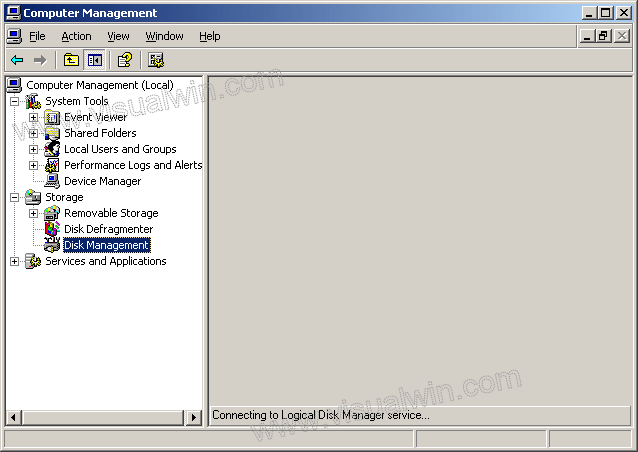
When it's done loading you should see something like the following

There it is! That's the drive's partition we've been looking for! Right click it, and click "Change Drive Letters and Paths..."

In the new dialog box you'll see and empty list box - that's where our drive letter will be. So Click the Add button

You now have the option of either making this hard drive show up in place of an empty folder on another NTFS drive (like if C:\imbored is an empty folder, we can mount the drive there, and all the contents of the drive will show up in C:\imbored) but in this tutorial we will use a drive letter, in my case, E:

Now you can close Computer Management and load "My Computer". You'll see that our new drive is now there!
Disabling Automatic Updates on Windows Server 2003, step-by-step
Preface:
Windows comes with a built-in feature to keep your computer always up to date with windowsupdate by including a program called Automatic Updates. Personally, I want to know when I'm updating my server and not let some program do it for me, so in this case we would disable it.
Method:
Click the Start button, then right click My Computer and click Properties

Now, go to the Automatic Updates tab, and click the checkbox (to de-select) "Keep my computer up to date..." and click Apply then OK

Enabling the CD-Burning Service on Windows Server 2003
Preface:
In theory you should use a workstation to write CDs, but in the few situations you may find yourself with the need to burn CDs from within Windows Server 2003.
Method:
Click Start, Administrative Tools, then Services

Scroll down to the "IMAPI CD-Burning COM Service", right click it and click Properties
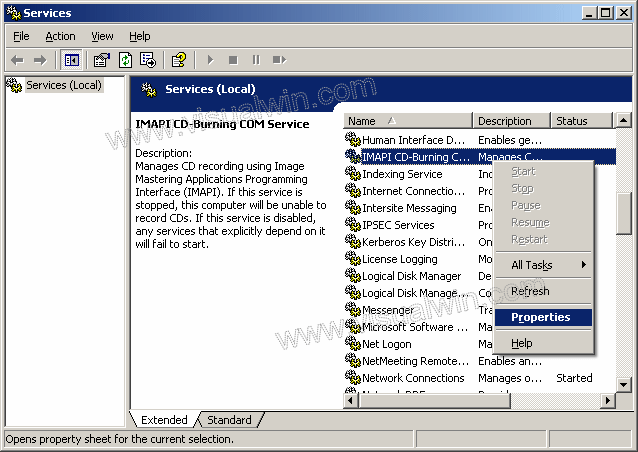
Set the Startup type to Manual, !Click Apply!, Then click Start.
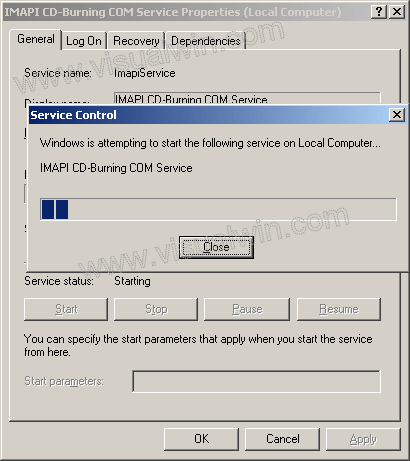
Press OK and we've enabled the CD burning service, install a CD burning program, and you should be able to write CDs. When you reboot, the service won't be started at boot, but when you try to burn a CD it will start (and when you are finished with the CD the service will stop again).
Creating a New User on Windows Server 2003
Preface:
Even if you will not be using Terminal Services or have any other users using your server it is ALWAYS recommended to create an additional two (2) users, apart from Administrator. These two users are - another member of the "Administrators" group (to avoid actually logging on with the Administrator account, but you have the same privileges) AND a regular user, who is part of the "Users" group. It is recommended to only log on with the regular user, and use the "runas" command when you need to run a program as an Administrator, and to only log on with the secondary Administrator user when it is absolutely needed. This will show you how to create a secondary Administrator.
Method:
Click the Start button, then Run...

Then type "lusrmgr.msc" without the quotes

In the window that opens, right click in the right panel and click "New User"

In the New User dialog, type in your preferences for a new user name and password (this will be our secondary Administrator account). Uncheck User must change password, and check Password never expires

Now, right click the new user and click Properties in the pop up menu

Go to the "Member of" tab and press the Add button

Type "Administrators" without the quotes, then press the Check Names button (to complete the name, it will add the name of your computer) and press OK when it is done, then press OK on the Local Users and Groups dialog

We now have a secondary Administrator account! To have a regular user (highly recommended) do the same as above, until the User properties.
My reasoning
Q: If I already made a new Administrator account why do I have to make a user account?
A: You don't have to, you never have to, but it is recommended in case you stay logged on, and someone gains control of the desktop (locally or remotely).
Q: Should I stay logged in with the Administrator account or the plain user account?
A: You should log out when you are not doing work on the server directly, however, if you have a program that requires you to be logged in for it to work (a good example is the bandwidth monitoring program, DU Meter) then you should stay logged in with the ordinary user account.
Disabling Application Error Reporting on Windows Server 2003 (and XP, also)
Preface:
There is absolutely no good reason to disable this service in pre-release, or released software. If a program or computer crashes, then once the computer recovers it makes a detailed report (with no personally identifiable information it) about how the crash happened and sends it off to Microsoft. They then look over it, and try to fix it, which makes a better OS for everyone. This is not a recommended procedure.
Method:
Click the Start button, and right-click My Computer and click Properties from the pop-up menu

In the System Properties dialog that has come up, click the Advanced tab, and then the Error Reporting button

In the next dialog click the Disable radio button, and optionally, so you don't get any notices of system failures at all, uncheck But notify me...
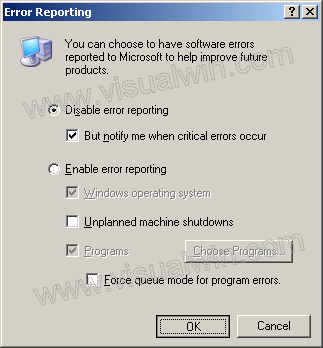
Now press OK, Apply, and OK, and Error Reporting has now been disabled.
Enabling sound on Windows Server 2003, Enterprise Edition
Preface:
Windows Server 2003, Enterprise Edition comes with sound disabled. Windows Server 2003, Standard Edition comes with sound enabled. If sound doesn't work for you in Standard edition then check the drivers, etc. Once again, sound being disabled is not a problem for Standard users :-)
Method:
Click Start, Administrative Tools, then Services

Scroll down to Windows Audio, and double click it, set start-up to Automatic, click Apply, click OK, then click Start

Not Requiring Ctrl-ALT-DEL at logon
Preface:
As a security feature of Windows NT based operating systems (NT 4, Windows 2000, Windows XP as a domain member or under certain settings and Windows Server 2003) you are required to press Ctrl-ALT-DEL before being prompted for a user name and password at log-in. Personally I like the feature but some people do not, so I'll show you how to disable it :o) Please note: This will not auto-login for you, it will only disable the C-A-D prompt and jump right to the login screen.
Method:
Click Start then Run..

In the Run box type "gpedit.msc"

Under Computer Configuration Click the + next to Windows Settings, then Security Settings, Local Policies then click on Security options

Double click Interactive Logon: Do not require CTRL+ALT+DEL and set it to Enabled, then press OK

Disabling the Shut Down Tracker
Preface:
The shut down tracker is used to...well...track the reasons a computer is going for shut down. As a server, a computer should not be shut down or rebooted manually very often, which is why this feature is in place. Some people, however, find it irritating so it can be disabled if you'd like.
Method:
Click Start then Run..

In the Run box type "gpedit.msc"

Click the + sign next to Administrative Templates (the one in Computer Configuration under Local Computer Policy) then click System
Double click Display Shutdown Event Tracker (highlighted above) and select the Disabled radio button and press OK
Enabling DirectX and Graphics Acceleration on Windows Server 2003
Preface:
You should NOT enable DirectX and Graphic Acceleration on this OS. It is a server, and is meant to be used as one.
Method:
Right-click on your desktop and select Properties

Go to the Settings tab and click Advanced

Go to the Troubleshoot tab and move the slider to Full

Press OK and OK.
Now go to Start->Run... and type dxdiag, after a little wait the progress indicator should disappear. Now go to the Display tab and make sure the 3 DirectX features are Enabled
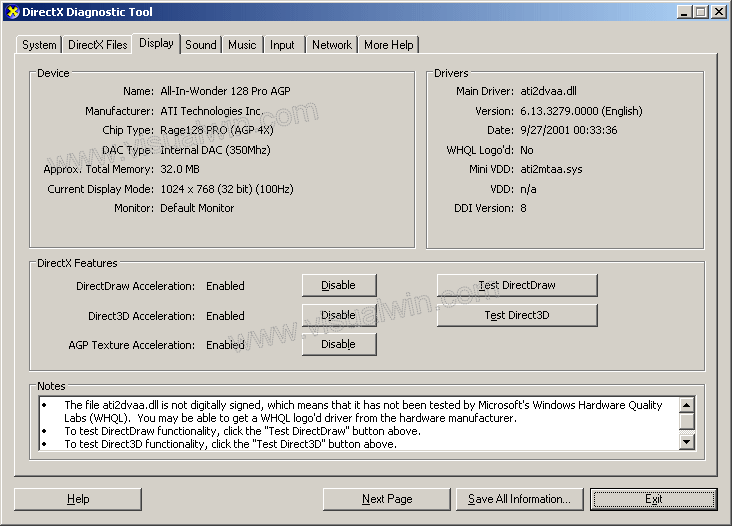
You've just enabled DirectX and Graphics Acceleration
Enabling the Luna (Windows XP) theme on Windows Server 2003
Preface:
Enabling themes is an unsupported and not recommended thing to do in Windows Server 2003 and CAN CAUSE INSTABILITY!!
The method:
First, click Start, highlight Administrative Tools, then click Services. (Also, remember how this Start Menu looks because it will be the last time you see it like this unless you go back to the Windows Standard theme :-)

Scroll down to "Themes" and double-click it, set the start-up type to Automatic, Apply, and then Click "Start" (Start will only become enabled after you set the Start-up to Automatic and !click Apply! [or manual, but you don't want that]) And press OK to leave the window

Now right-click your desktop, and click Properties

Under theme click Windows XP, then click Apply, and congratulations, you've enabled Luna

You may also want to refer to the Direct X how-to page for instructions on speeding up graphics, etc
Disabling Internet Explorer Enhanced Security Configuration on Windows Server 2008
Looking for the Windows Server 2003 version of this tutorial? Click here.
Preface:
Windows Server 2003 and, subsequently, Windows Server 2008 shipped with security locked down by default. Part of this locking down is Internet Explorer Enhanced Security, which is an extra layer of protection when surfing the internet using Internet Explorer (more information can be found by going here on a Windows Server 2008 [test] machine). Some people want to diable it. That's OK, Microsoft allows that, and that's what this tutorial will show you how to do. As we will soon see, we have the option to disable the Enhanced Security Configuration (ESC) for Administrators, Users, or both. In this tutorial, we will be disabling it for both types of user.
Method:
Click Start, move your cursor over Administrative Tools, and click Server Manager

Now, under "Security Information" on the main Server Manager pane, click Configure IE ESC
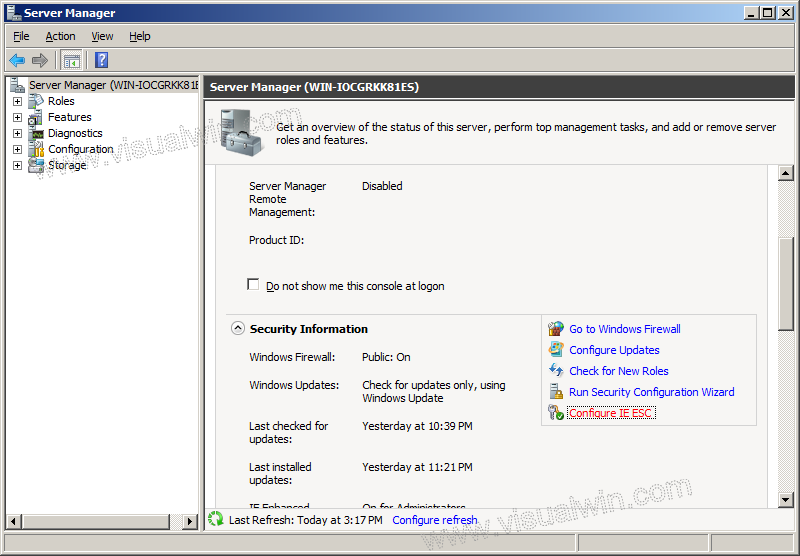
The Internet Explorer Enhanced Security Configuration will open, allowing you to choose whether to have it enabled for Administrator and/or User groups. Because in this tutorial we are disabling the configuration for all users, we set both radio buttons to "Off", and press "OK".
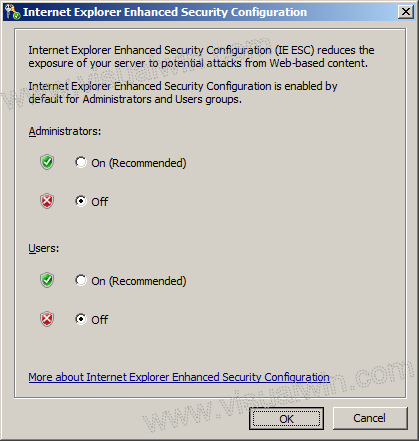
And that's all! From the next time Internet Explorer is loaded, IE ESC will not be enabled.
Questions:
Q: How do I know if it is enabled?
A: Upon loading Internet Explorer, the home page will tell you:
Internet Explorer Enhanced Security Configuration is enabled
Q: How do I know if it's disabled?
A: When you load up Internet Explorer Internet Explorer will tell you:
Caution: Internet Explorer Enhanced Security Configuration is not enabled
Abonneren op:
Posts (Atom)









